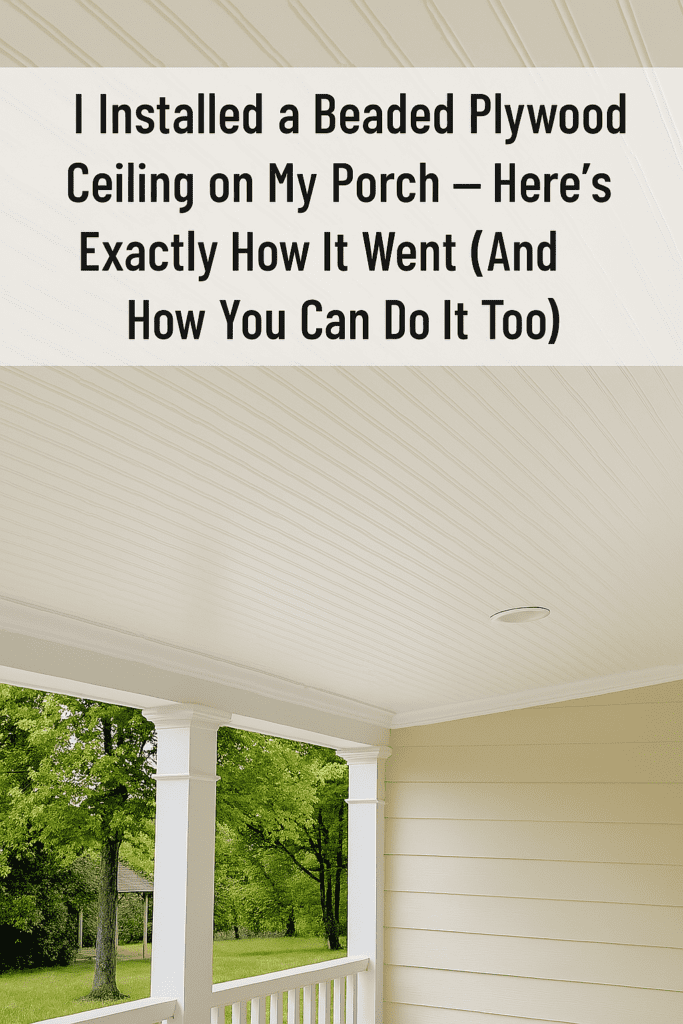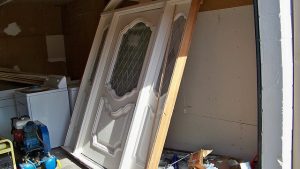One Saturday morning, I was drinking coffee on our back porch when I looked up and finally admitted it—our ceiling looked awful. It was old drywall, cracked in spots, and a stain shaped like Florida spread from one corner. I wanted something that actually looked intentional. Cozy. Finished.
I looked into all kinds of options—tongue-and-groove boards, PVC beadboard, even reclaimed barn wood. They were either too expensive or too fussy to install. Then I stumbled across beaded plywood panels at the local lumber yard. They had just enough character, were light enough to lift solo, and best of all, were cheap.
Here’s exactly how I installed a beaded plywood ceiling on our porch. I’ll walk through every step, the tools I used, the mistakes I made, and whether I’d do it again. If you’re handy and have a long weekend, this is a very doable DIY.

What Is Beaded Plywood?
Beaded plywood comes in 4×8-foot panels and has grooves (or “beads”) milled into the surface every few inches. It mimics the look of beadboard or tongue-and-groove paneling but is way faster to install. It’s often used on porch ceilings, laundry rooms, or mudrooms to add a touch of texture and cottage charm.
You can find it in 1/4″ or 3/8″ thickness. I used 1/4″ because it’s lightweight and I was installing over an existing ceiling.
Tools & Materials I Used
Here’s everything I used to install the ceiling. Some I had already, some I bought just for this project:
- Beaded plywood panels (1/4″)
- Construction adhesive
- Circular saw
- Stud finder
- Chalk line
- Brad nailer + air compressor
- Wood filler
- Paintable caulk
- Crown molding (PVC)
- Exterior paint or stain
- Safety gear
- Scrap 2x4s for T-braces
Step 1: Prep the Ceiling
First, I removed the old light fixture and gave the ceiling a once-over. I scraped off any peeling paint and wiped it down with a damp rag. Our porch has a roof but is open on two sides, so I needed to make sure the surface was clean and dry before I glued anything.
I used a stud finder to locate the joists above the drywall. Then I snapped chalk lines across the ceiling so I’d know where to drive my nails. You do not want to miss the joists — the panels will sag over time.
Step 2: Cut the First Panel
I measured the distance from the wall to the center of the nearest joist, marked the panel, and cut it with my circular saw. The beaded pattern runs along the 8-foot length of the panel, so keep that in mind when you’re laying things out.
Pro tip: Sand any rough edges. Splinters overhead are no joke.
Step 3: Make DIY T-Braces (These Saved Me)
I was working solo, so I made two T-braces out of scrap 2x4s. Just a vertical post about the height of the ceiling, and a 3-foot crossbar screwed across the top. These held the panels in place while I glued and nailed them.
If you don’t make these, you’ll either need a helper or some serious arm strength.
Step 4: Glue and Nail the Panels
I ran beads of construction adhesive on the back of the first panel, lifted it into place with the T-braces, and adjusted it so the grooves lined up parallel to the wall.
Then I used my brad nailer to tack it in place along the joists. I nailed every 6–8 inches. The adhesive does most of the holding, but the nails keep things tight while it sets.
Each panel went up the same way. I staggered the seams for a more natural look.
Step 5: Fill Gaps, Caulk, and Paint
Once all the panels were up, I went back and filled the nail holes with wood filler. I also caulked the seams between panels and where they met the walls.
Then I painted everything with two coats of satin white exterior paint. The grooves in the beaded plywood looked crisp and clean, and the white brightened up the entire space.
Step 6: Add Crown Molding (Optional But Worth It)
To finish the look, I installed PVC crown molding around the perimeter. It covered any small gaps between the panels and the walls and gave everything a polished feel. I used a miter box and handsaw to cut the corners, then nailed it in place and caulked the joints.
If you want a clean, professional-looking ceiling — do this step.

Final Thoughts: Was It Worth It?
Absolutely. The whole project took me about a day and a half, start to finish. It completely transformed our porch, made the space feel finished, and only cost around $300 all-in.
Would I do it again? Yes — but I’d prime and paint the panels before installing them. Painting overhead is a pain.
If you’re on the fence, go for it. Beaded plywood is an affordable, beginner-friendly way to upgrade any ceiling — porch, sunroom, or even indoors.




